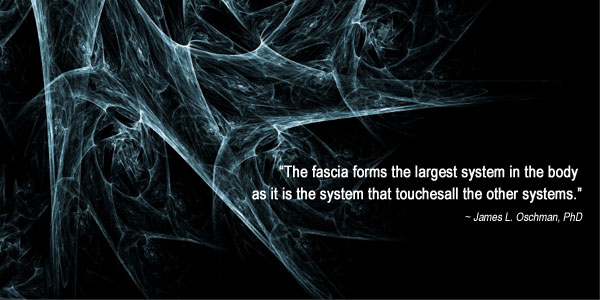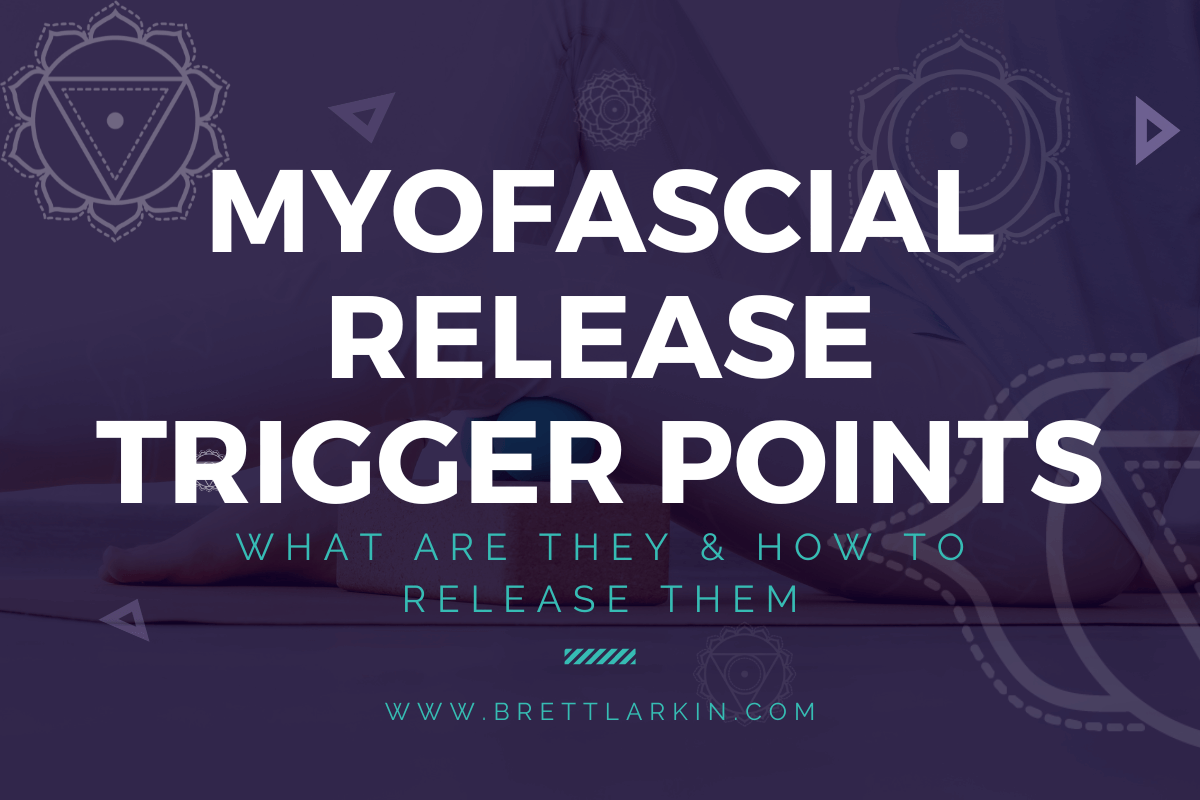As a yogi on the internet you’ve most likely seen talk of fascia or myofascial pain syndrome and trigger points. And if you haven’t, pause here and read what fascia in the body is to get up to speed. I’ll wait….
Okay great, now that you know all about fascia let’s talk about myofascial release trigger points! What are they? How do you get them? How do they affect the body? And most importantly how to release them!
What Are Myofascial Release Trigger Points?

Myofascial release trigger points are hyperirritable spots in the fascia surrounding muscle tissue, often referred to as “knots.” These trigger points, or painful knots, can cause localized and referred pain, tension, and restrict your movement. Trigger points can cause pain during movement or while the body is stagnant. Myofascial release is a therapeutic technique used to release these trigger points. It involves applying gentle, sustained pressure to these points to alleviate discomfort and improve mobility, but more on that later 😉.
A myofascial trigger point is often caused by habitual bracing patterns. This can be due to emotional stress(hunched shoulders for example) or physical trauma(a fall, accident, or eve muscle overuse). This happens because your body wants to take care of you, so your fascia forms into a trigger point or “knot” in order to support itself. These trigger points don’t just cause pain in the affected muscle, they can cause chronic pain throughout the body. Everything is connected after all.
Myofascial release is a holistic approach to healing, integrating mindfulness and body awareness to provide pain relief. It encourages you to connect with your body, recognizing areas of pain related tension and addressing them through conscious breathing, soothing movement, and self massage. Additionally, myofascial release encourages relaxation and promotes a sense of well-being. By focusing on both physical and mental aspects, this practice supports overall health and vitality.
Your fascia is such a huge part of your musculoskeletal system. It doesn’t often get the attention it deserves from us or from science. This is why I have an entire module on the fascial system inside my 200-hr Yoga Teacher Training and created my fascial fitness series.
Benefits Of Releasing Trigger Points

There are numerous benefits to releasing trigger points in the body. You might be pleasantly surprised by how much working with your fascia can have a significant impact on you, enhancing physical well-being and overall health.
Some of the key advantages to myofascial trigger point therapy include:
Pain Relief
Trigger point therapy whether it’s working with a therapist, doing trigger point injections of nonsteroidal anti inflammatory drugs and dry needling, or trying self massage can alleviate musculoskeletal pain. This happens by releasing muscle tension and improving blood flow, reducing painful symptoms in areas such as the neck, shoulders, and back.
Reduction In Tension Headaches
A lot of us experience tension headaches. Especially if you sit hunched over a computer or your phone for most of the day. This repetitive movement leads to tension and myofascial pain. One of the many benefits of releasing myofascial trigger points is the reduction of headache frequency and intensity. Trigger point therapy can effectively decrease tension-type headaches by targeting and releasing tension in the neck and shoulder muscles.
Improved Range of Motion
Oftentimes the stagnant nature of the modern world and injury cause stiffness, impeding your range of motion. This is due to muscle tightness. By addressing your trigger points and easing muscle tightness, this therapy enhances flexibility and range of motion, helping with everyday activities like bending and reaching.
Better Posture
Poor posture can cause trigger points and myofascial pain. Simultaneously trigger points can cause tension leading to poor posture. Working to release those trigger points will make it more comfortable to stand straighter and taller. Being mindful of your body’s position also helps you correct posture more easily and effectively.
Enhanced Athletic Performance
Athletes often experience better performance and reduced injury by using myofascial release and massage. This is not exclusive to trained athletes however. If you are a runner, or just want to improve your performance in any physical exercise, releasing trigger points keeps the muscles loose and warm. Thus reducing risk of muscle injury and allowing muscles to function more efficiently.
Stress Reduction
Myofascial release not only relieves stress on the body but also stress on the mind. When you feel good in your body you feel good in your mind. It helps to release emotional patterns and leaves you feeling relaxed and less anxious/stressed.
Better Sleep Quality
When you’re uncomfortable or dealing with pain from myofascial pain syndrome, sleep can be hard to come by. Often people turn to the use of muscle relaxants just to get some rest and combat sleep disturbances from localized muscle pain. When you release trigger points you will alleviate muscle discomfort. This leads to improved sleep patterns, helping you achieve more restful sleep. This is a beautiful cycle because better sleep patterns also equal better capacity to heal 🥰.
Improved Mental Health
Myofascial release has been shown to ease symptoms of anxiety and depression. This is because your fascia responds to the trauma in your life, creating bracing and pain patterns in response. When you relieve the fascia of those bracing patterns you simultaneously create an emotional release. Not only will you feel more freedom physically but also mentally.
Just looking at this short list of benefits illustrates the comprehensive impact of trigger point release on both physical and mental health. This is why everyone can benefit from myofascial trigger point release.
How To Release Trigger Points

As previously stated, trigger points are tight areas within muscle tissue that can cause muscle tenderness and pain. This pain may not only manifest in the location of the active trigger point but cause widespread pain in the surrounding muscles and other parts of the body. So how do you get those trigger points to go away?
The following are some techniques to release trigger points and reduce pain:
1. Trigger Point Massage
If you don’t like the idea of a trigger point injection from a physical therapist give trigger point massage a try. You can do this yourself or with a massage therapist. This involves applying pressure to the trigger point to assist in its release. Use your fingers, a massage ball, or a foam roller to apply firm pressure to the trigger point for 30 to 60 seconds. Its your own personal massage therapy session.
Don’t forget to breathe! If you can’t take a full breath you are pushing too hard and need to lighten up. As you feel the pain and muscle start to ease you can gradually increase the pressure as tolerated.
2. Stretch the Muscle
Gently stretch the muscle that contains the trigger point. Hold the stretch for 20 to 30 seconds, and repeat several times to help relax the muscle fibers. Stretching creates traction along the muscle fibers and can get into some of those latent trigger points. You can read more about that and specific stretches to help with active trigger points here: self myofascial release.
3. Heat Therapy
Heat therapy is a great way to relax and increase blood flow into the affected muscle. If you can, sit in a sauna, apply a warm compress or take a warm bath, this allows the fascia and skeletal muscle to be more pliant and mobile. Thus, making it easier to release the trigger point that may be affecting your muscles.
4. Use a Massage Gun
Myofascial release tools are incredibly helpful when it comes to easing chronic myofascial pain syndrome, and releasing trigger points. Try using a massage gun on a low setting, gently apply it to the affected area for a few minutes to help break up the tight tissue.
5. Practice Deep Breathing
The body needs to feel safe in order to start healing. Deep breathing helps to relax your body and enhance its sense of safety. When you are relaxed and in a comfortable state you improve the effectiveness of the trigger point release techniques. I would definitely recommend practicing pranayama or somatic breathing exercises prior to beginning myofascial release.
6. Movement Therapy
Movement therapies where you move in non-habitual ways are great for hydrating and mobilizing your fascia. This will make it easier to break up active myofascial trigger points. This can include therapies such as: yoga, tai chi, somatic workouts, and physical therapy when working with a licensed therapist.
These are all great methods to work with myofascial pain. And what’s great is you can do most of them at home on your own. There are plenty of other methods to help relieve myofascial pain syndromes symptoms too.
Some other treatments for myofascial trigger point include:
- Physical Therapy – A physical therapist can provide a physical exam to create personalized exercises and stretches to relieve pain and improve muscle function.
- Dry Needling – This is a method in myofascial therapy where a therapist inserts thin needles into the trigger point to release tension and improve circulation.
- Acupuncture – This traditional practice uses needles to stimulate specific energetic points, promoting healing and pain relief.
- Ultrasound Therapy – High-frequency sound waves are used to promote blood flow through the soft tissue and reduce muscle tightness.
- Electrical Stimulation – Devices like TENS units deliver electrical impulses causing a local twitch response to help alleviate pain and muscle spasms.
- Medications – Physical medicine like over the counter drugs/pain relievers or prescribed muscle relaxants can help manage discomfort and inflammation.
- Relaxation Techniques – Practices such as yoga, meditation, and deep breathing can help reduce stress and muscle tension.
- Hydration and Nutrition – Staying hydrated and maintaining a balanced diet supports overall muscle health and recovery.
Closing Thoughts
If you have myofascial pain syndrome or are experiencing myofascial pain it is important to consult with either different physical therapists or specific myofascial trigger point therapists to see what treatment plan will work best for you. You can also take your healing a step further by exploring somatic healing (a practice I personally LOVE 😍). Remember, you know your body best and your body knows what it needs to heal, trust it and do what feels right for you.
Next Steps
- Take a deep dive into embodiment and somatic yoga with my Somatic Yoga certification program.
- If you’re interested in practical kriya yoga as a way to improve your daily life and relationships, check out my Yoga for Self Mastery course.
Experience 3 Training Videos from Inside My 200-Hour Online YTT

YOU MIGHT ALSO LIKE
- How to Teach Somatic Yoga: A Practical Guide for Instructors
- The Best Somatic Exercises for Grief: Find Healing Through Movement
- The Best Somatic Exercises for Anger Management and Emotional Release
- How to Teach Somatic Yoga to Beginners
- Best Somatic Yoga Poses for Emotional Release and Healing
- The Rich History of Somatic Yoga: From Origins to Modern Practices
- Somatic Yoga for Stress: Effective Techniques to Find Calm and Relief
- The Perfect Yoga Practice For Your Menstrual Cycle Energy Levels
- Enhancing Your Practice: The Benefits of Yoga and Nature Connection
- Gentle Somatic Yoga for Back Pain: Relief and Prevention Techniques
- How Somatic Yoga for Anxiety Can Help You Find Calm and Balance
- Somatic Stress Release Techniques for Emotional Balance
- Progressive Muscle Relaxation Meets Yoga for Deep Sleep
- 5 Somatic Hip Exercises For Beginners
- How To Relieve Myofascial Pain with Yoga: Heal and Prevent Muscle Tension











